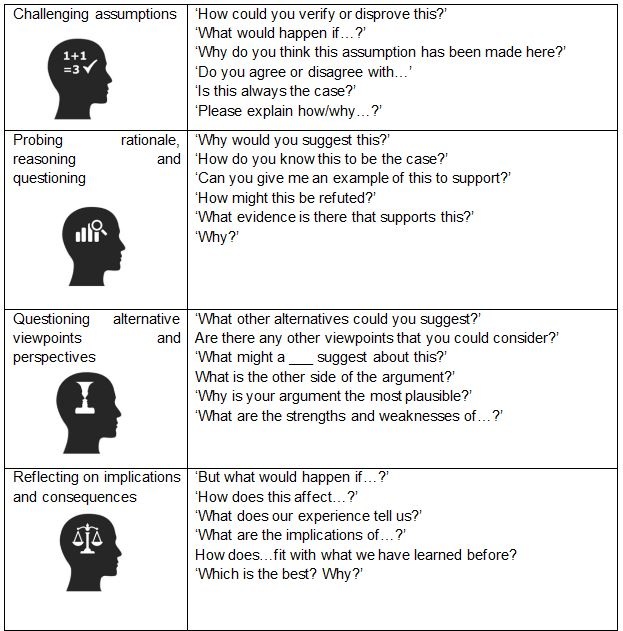
The ability to incorporate dialogic teaching is one of the first steps in ensuring that you have considered, and are building on, the oracy skills of your learners. In Talking about Oracy, it’s recognised that both monologic and dialogic approaches can be adopted based on contextualisation and the practitioner.
By incorporating monologic strategies, you are in essence modelling best practise. However, dialogic teaching strategies can be at the heart of deepening the learning process and allowing students to personally consider more theoretical approaches through the development of logic and contextualisation.
In order to combine the two approaches, questioning strategies such as ‘hinge questions’ can be used as the doorway that can lead leaners into knowledge acquisition. These hinge questions act as a formative assessment technique during a lesson that can allow the teacher to gauge initial student understanding. This diagnostic tool can then provide a generalised indication of the level of mastery in the room, alongside deciding whether to continue as planned or to readdress a key aspect.
Examples of these diagnostic tools include:
- Some schools choose to incorporate a ‘traffic light’ system in their academic journals or as a classroom tool that can be used to indicate pupil comprehension
- Red = confused and lack of understanding
- Amber = starting to comprehend but more support needed
- Green = understand and confident.
This is a good starting point to open up discussion and to gauge the level of comprehension of all students individually.
- For a quick and easy formative assessment, asking students to indicate their understanding using their hand and a 1-5 scale is quick, cheap and efficient.
- Since there has been such a shift towards remote learning strategies and the incorporation of electronic devices, the ability to use self-marking forms and shared writing tools has actually opened a wealth of alternative diagnostic approaches.
- For a more in-depth understanding, retrieval practice is an effective tool to not only judge the comprehension of a topic, but it can also allow the teacher to interleave other topics into the questions in order to support knowledge retention. Whether choosing to ask one question, or a series of questions, these answers will provide a quick understanding of the climate and what areas need further development. Once again, feedback to this can be delivered either in a monologic fashion, based on teacher perception and initial analysis of results, or through dialogic conversation between peers.
Whatever approach you choose to take when it comes to assessing student comprehension, the most important part of any formative assessment is what directly follows the acquisition of this information.
A common misconception, particularly when practitioners are still new to the classroom, is to see this strategy as more of a ‘tick box’ exercise as opposed to a diagnostic tool. Their integration of a formative assessment in their lesson structure is there merely to appease the face at the back of the room (it’s a ‘go to’ for lesson observations). However, just the assessment on its own would be deemed inappropriate and a complete waste of time. It’s what is done as a result of this information that is particularly important to the development of learning.
Based on the hinge question, practitioners can then determine the best course of action to take in order to continue the students’ learning journey.
- Green/Confident results
Continue with the approach that you have intended, however if this approach is monologic, this would be a good time to encourage a discussion in order to articulate the learning and explain their current acquisition.
- Amber/Hesitant results
These are typically the results that often spur a teacher into continuing with their approach in the hopes that learning will be embedded more succinctly by the end of the lesson. Once again, allocate time after your whole-class results in order to promote a discussion between students. Often issues lie in an inability to articulate their knowledge and therefore understanding can actually be achieved by just recanting the information whilst summarising in their own narrative. This can then be followed with dialogic questioning and revisiting the information in order retain the knowledge through spacing strategies (it would be useful to make a note of the topics and the results of these diagnostics so that you can plan retrieval practise exercises accordingly).
- Red/Reluctant results
These can sometimes be an issue with comprehension, however it could also be an issue with confidence. As the class teacher, the true reasoning could fall on professional judgement. The key factor to remember when this happens is to find out the extent of the issue. Once again, allow discussions to support you! By allowing the time for a reflect and review session with their partner, students will not only feel like they are able to share their confusion, or support someone else to finding understanding, but also it could be used to ask the question of ‘why?’. By asking students to consider ‘why?’ they have chosen this level of comprehension, they should then hopefully be able to indicate their key areas of improvement.
Consequently, the results obtained need to be used to guide the proceeding approach. Whether deviating or developing, hinge questions can often be used as a catalyst for discussion. It is at these moments that oracy skills and the students’ ability to communicate with their peers can be fundamental in encouraging students to share and digest the information that they have been exposed to. The incorporation of questioning into your lessons needs to be done in a way that considers and utilises the efficiency of dialogic questioning, not just by the teacher, but also through the encouragement of peer-to-peer conversation in order to embrace their speaking and listening skills.
Dialogic questioning: developing a deeper comprehension through Socratic talk
Dialogic questions can often alter depending on the setting and cohort. For example, building strategies in the secondary classroom involves a lot less of a focus on one-to-one questioning and development as there are often limitations and factors that would impact on effective delivery of such techniques. The high concentration of learners presents the need for the teacher to be able to acquire immediate interpretations of knowledge acquisition (predominantly through formative assessment and closed questioning) quickly in order to understand the learning process in action.
However, these responses will generally only give us a surface level understanding of our students. The need to enable and develop deeper critical thinking is dependent on how the learning proceeds. As Socrates himself once said, ‘Questioning is the only defensible form of teaching’. The very premise of learning and development is hinged on the ability to retain and retrieve that knowledge, whether this be in the short term, or in the long term through cognitive retrieval.
The ability for students to utilise the power of talk and engage with their oracy skills to support the thinking process not only deepens their understanding of subjects, but it also enables the teacher to diagnose a more summative analysis of the understanding. It can also support the evaluation of their ability to communicate with one another and listen to alternative interpretations.
No matter what subject is being taught, the implementation of Socratic questioning, either in a group environment, or alternatively as a whole-class discussion, can be used to:
- Provide controlled support to the discussions taking place.
- Explore more complex ideas in a structured way that allows for visible development.
- Analyse and justify concepts in a professional and detailed manner.
- Provide an overview of the learning climate.
- Identify and challenge any misconceptions
The benefits of adopting strategies like the implementation of Socratic questioning, is the focus that is placed on the opportunity and encouragement of development and the expansion of ideas. The consequences of such techniques will not only enable students to develop confident oracy skills through intellectual dialogue, but they will also be provided with a skill that could easily be transferred to extended writing tasks.
The Six Socratic Questions
The entire premise behind this form of questioning relates to 6 questions that should be asked in order:
- Clarifying thinking and understanding
- Challenging assumptions
- Probing rationale, reasoning and questioning
- Questioning alternative viewpoints and perspectives
- Reflecting on implications and consequences
- Metacognitive questions
The use of Socratic questioning can be controlled and developed through the use of a supportive script that can either be used for teacher guidance, or alternatively as a discussion road map for students in collaborative groups. Each of these six question outlines can be used by choosing the appropriate questions to ask based on the content, topic and the path of the discussion.



If you choose to adopt this technique as a teacher, the key is to remember the steps and process that can be taken in order to develop the learning of your students through challenge. Don’t forget that these techniques should never be reserved specifically for higher ability students. The ability to question our thinking and rationalise our thoughts is a skill that can and should be demonstrated and nurtured for everyone, no matter the supposed ability. The only differentiation will be the answers that are obtained from these responses and perhaps the time and support allocated to achieving the most developed responses.
Sometimes we see this technique being presented as some form of well-scripted theatrical performance, with chairs in circles and different students with different roles. Although a desirable spectacle that, if crafted correctly, could be one of the most beautiful demonstrations of incorporating oracy in the classroom, we need to be realistic. It is the ability to incorporate these skills (where possible) into all lessons as opposed to one-off opportunities that will consistently allow students to achieve critical thinking. The more they attempt theses skills, the less they will look like some random disco being attended by a group of individuals who have no idea how to dance!
Sarah Davies is a lead practitioner and head of English in a multi academy trust secondary school. She is also a lead examiner for a national exam board. Her book, Talking about Oracy: Developing communication beyond the classroom, published by John Catt Educational, is out now, price (£14) for more information click here..
Register for free
No Credit Card required
- Register for free
- Free TeachingTimes Report every month